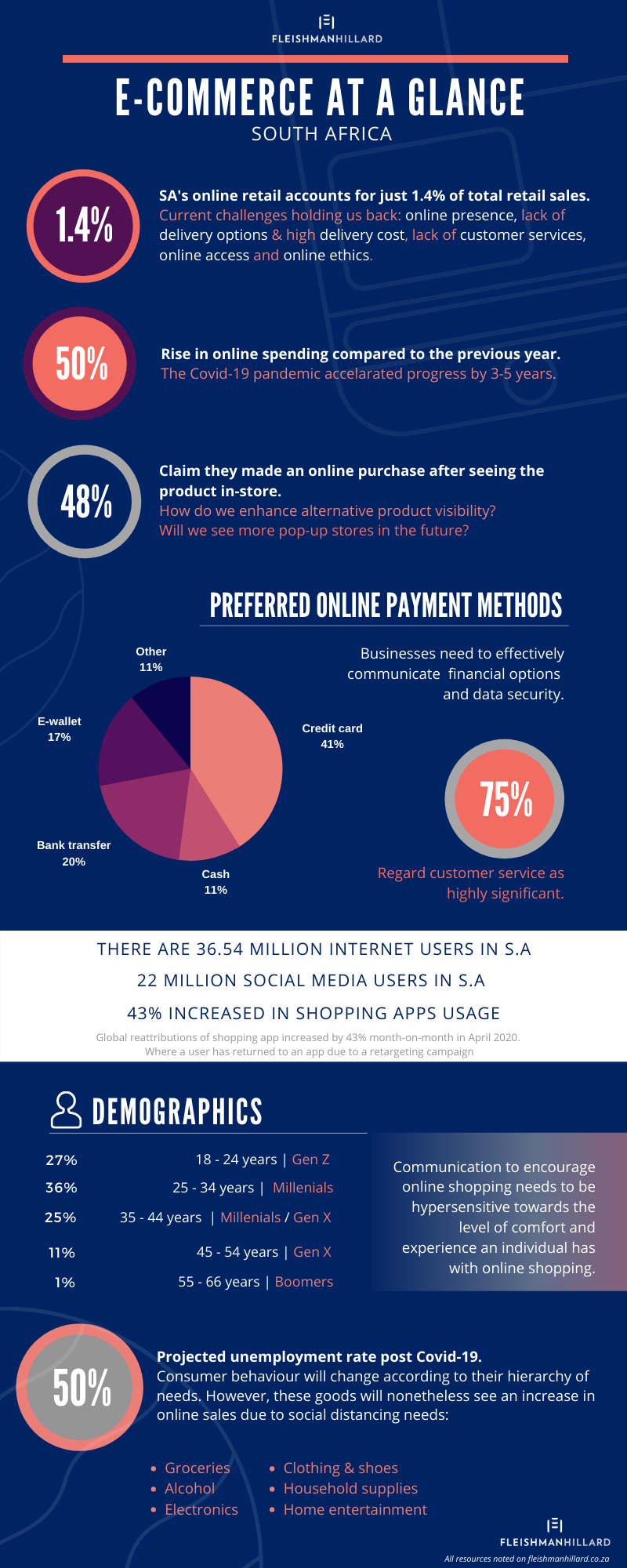Online shopping in South Africa: are your virtual doors open for business?
If there’s one thing we’re good at – it’s spotting an opportunity in crisis. Unfortunately, the crisis we do speak of is the global pandemic that has shaken the foundation of our day-to-day behaviour and ways of working. The new social and economic environment we’re faced with has forced South Africa, and the world, to act fast and adapt where possible. In particular our uptake of digital and social solutions, and more specifically, online shopping in South Africa.
“E-commerce in the country has been accelerated by 3-5 years, which has brought South Africa closer to international levels.” – OneCart CEO, Lynton Peters
Welcome to my shop; let me know if I can assist?
Old or new, with a legacy or fresh on the block, if you rely on sales of a product or service, you have to treat the extension or complete move-over to a virtual shop just as serious as a real store. And it’s not just being available online, it’s whether you’re communicating your services correctly. It must be a holistic approach that ensures the customer is prioritised during the user-experience (shopping) journey and that you have all your communication avenues clear and open for when a customer needs assistance – just like in a real store.
“South African e-commerce market is an untapped billion-dollar industry, and this is an opportunity for the Government to create a policy and regulatory environment that enables a localised, innovative, inclusive, e-commerce model that uses existing logistics systems to drive the industry.” – Alison Gillward, ICT Africa.
Adjusting your strategy for success
Being aware of your audience demographic and spending methods play a large role in crafting your online communication strategy. We detail and breakdown the latest shopping behaviour and online activity in South Africa here or for the TL;DR version:

Being aware of your audience demographic and spending methods play a large role in crafting your online communication strategy. This includes addressing their fears and needs: 50% of people who have not shopped online agree on having the fear of missing a delivery or waiting around all day, high delivery cost, and scams.
Again – “Welcome to my shop, how can I help you?”
The team at FleishmanHillard, has seen firsthand over the past decade how social media platforms have become the new customer service portal. One of our most popular social/digital offerings are social media playbooks consisting of every possible FAQ a customer can think of, accompanied with a master map or ‘response matrix’ of who to escalate to in the business, in order to close the loop on a query or complaint. And I cannot stress enough, how important an efficient community manager is to the business and the potential incorporation of smart chatbots and AI.
Social platforms are adapting to help businesses
Facebook and Instagram are adding ‘Shops’ to let businesses sell products through the social network, in addition to the existing Marketplace where individuals can trade among each other. Selling via your social media pages is a great way to be closer to your customer with fast response time and they can increase your share of voice with the share and reaction functions. This excludes buying ad space for product and service catalogues on Facebook, Instagram and Pinterest.
Let social media be a key driver for success
With a targeted approach, your new venture into the world of e-commerce can be effectively communicated via your social media pages, directly with the audience you want in your virtual store.
Using a combination of paid ads, organic, and online shop fronts (catalogues listed on Facebook, Instagram, and Pinterest) you can create a holistic approach to boosting sales and building a list of loyal customers. Rewarding customers is easier with digital coupons and offerings such as free delivery, etc.
Keeping a real store is still a plus as you can combine the shopping and marketing experience. Take it further with QR code scans in-store to unlock rewards while building valuable client lists. There may even be a rise in popup stores in the future to satisfy the need to see a product in real life. This can be combined with launch events (virtual or not) and compact digital campaigns to drive feet in existing stores.
“I think that is the nature of Covid-19, you do not have a choice; it’s either you adapt or you die.” – General manager of marketing retail and procurement for the company, Batya Bricker.
There’s no need to reinvent the wheel. It’s about readjusting budgets for new resources, while still putting the client first in all solutions. Now is the time to explore new avenues with the help from digital & communication experts and together use your business/brand to lead the way for the rest.
Download and use this complete e-commerce report for your next planning session.
Talk about doing business during this time, have you thought about launching a product in a pandemic? Paula has. Read it here.
Find Out More
-
Digital Insights Bulletin - October 2024
October 31, 2024
-
Sharon Piehl Wins 32nd Annual John D. Graham Award for Excellence
October 25, 2024
-
Digital Insights Bulletin - September 2024
September 30, 2024


